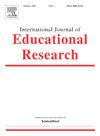COVID-19 大流行前后拉丁美洲的学校效率:来自 2018 年和 2022 年国际学生评估项目的新证据
IF 2.6
3区 教育学
Q1 EDUCATION & EDUCATIONAL RESEARCH
引用次数: 0
摘要
学校的效率可以用产出(成绩)与投入(人力和技术资源)之间的比率来衡量。一旦通过数据包络分析(DEA)技术获得了每所学校的效率水平,我们就可以评估整个教育系统在现有资源条件下是如何远离或接近最高效率教育前沿的。此外,我们还可以根据这一估计前沿来衡量学生、家庭和学校因素在不同方向上推动效率的重要性,以及效率--平等交易是否成立。这项工作与资源有限、不平等现象严重的全球南部教育系统的现实情况息息相关。在本文中,我们利用国际学生评估项目(PISA)的最新两波数据(年份:2018 年和 2022 年),即 4969 所学校的集合样本,为拉丁美洲地区(9 个国家)提供了新的证据。重要的是,考虑到调查的时间安排,我们能够比较 COVID-19 大流行前后的效率,对比主要的决定因素。我们发现,在地区层面,效率略有提高,从 0.75 提高到 0.78,而在九个国家中,只有三个国家(巴西、智利和哥伦比亚)的效率保持不变。总体而言,效率障碍在两个波次中都存在,信息和通信技术的获取以及学校类型和位置等系统性因素在大流行后与经验更为相关。此外,在大流行后,半数国家中获取起码知识的机会少与效率和包容性之间的关系恶化。在大流行病期间,学校得到了更多的支持,家里有了更多的信息和传播技术,与教师的交流也提高了学校的效率,而与教育当局缺乏协调则是一个障碍。本文章由计算机程序翻译,如有差异,请以英文原文为准。
School efficiency in Latin America before and after the COVID-19 pandemic: New evidence from PISA 2018 and 2022
The efficiency of schools can be measured as the ratio between the outputs produced (achievement) and the inputs utilised (human and technical resources). Once efficiency levels are obtained for each school through Data Envelopment Analysis (DEA) techniques, one can assess how an education system as a whole is either far or close to a maximum efficient educational frontier given available resources. Further, one can rely on this estimated frontier to gauge the importance of students, family and school factors pushing efficiency in different directions, and whether the efficiency-equality trade holds. This exercise is relevant to the realities of education systems of the global south where resources are limited and inequalities are vast. In this paper, we present novel evidence for the Latin America region (9 countries) by using the latest two waves of data from PISA (years: 2018 and 2022), a pooled sample of 4969 schools. Importantly, given the surveys’ timing, we are able to compare efficiency before and after the COVID-19 pandemic, contrasting leading determinants. We find that, at regional level, efficiency slightly increased from 0.75 to 0.78, and only being constant in three (Brazil, Chile and Colombia) out of the nine countries. Barriers of efficiency hold across the two waves overall, with systemic factors such as ICT access and school type and location being more empirical relevant post-pandemic. Also, the link between low access to minimum knowledge and efficiency, as well as inclusion, worsened post pandemic in half of the countries. During the pandemic, school efficiency was found to be boosted among others by higher school support, better stock of ICT at home and communication with teachers, whereas lack of coordination with education authorities was found to be a barrier.
求助全文
通过发布文献求助,成功后即可免费获取论文全文。
去求助
来源期刊

International Journal of Educational Research
EDUCATION & EDUCATIONAL RESEARCH-
CiteScore
6.20
自引率
3.10%
发文量
141
审稿时长
21 days
期刊介绍:
The International Journal of Educational Research publishes regular papers and special issues on specific topics of interest to international audiences of educational researchers. Examples of recent Special Issues published in the journal illustrate the breadth of topics that have be included in the journal: Students Perspectives on Learning Environments, Social, Motivational and Emotional Aspects of Learning Disabilities, Epistemological Beliefs and Domain, Analyzing Mathematics Classroom Cultures and Practices, and Music Education: A site for collaborative creativity.
 求助内容:
求助内容: 应助结果提醒方式:
应助结果提醒方式:


